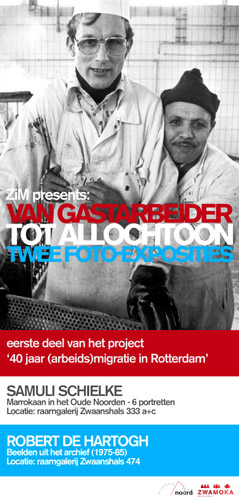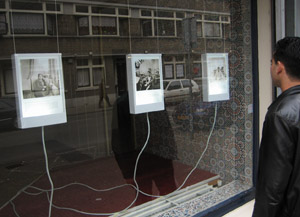back to the photo index
Click here
to view the series again (or click on the image of your choice)
or read more:
Moroccans are one of the largest immigrant groups in the Netherlands and probably the most stigmatized.
Despite the presence of successful politicians, artists, sportsmen and others of Moroccan origin, Moroccans
also have alarmingly high crime and unemployment rates, and to make things worse, they have been heavily
affected by the current fear of and confrontation with Islam. Not surprisingly, most Moroccans do not
recognize themselves in the negative image of crime, religious extremism and anti-integration obscurantism
that is often drawn of them, but would prefer to be shown and seen as the decent people they are.
 This photo series was commissioned
and curated by Daniela Swarowsky/ ZiM (Zwaanshals in Motion) for an exhibition on the history of labor
migration to the neighborhood of het Oude Noorden in Rotterdam (Van Gastarbeider tot Allochtoon, 22
April - 30 June 2006). It is an experiment in finding a balance between the image people want to show
of themselves, and the objectifying glance that public representations always are bound to have.
Rather than representing people according to preconceived expectations, it was designed to give
the people who appear in the pictures the power of self-representation: They should decide where
and in what setting they want to be photographed, and they should give a short statement of
their own choice, telling about themselves and things that are important for them.
This photo series was commissioned
and curated by Daniela Swarowsky/ ZiM (Zwaanshals in Motion) for an exhibition on the history of labor
migration to the neighborhood of het Oude Noorden in Rotterdam (Van Gastarbeider tot Allochtoon, 22
April - 30 June 2006). It is an experiment in finding a balance between the image people want to show
of themselves, and the objectifying glance that public representations always are bound to have.
Rather than representing people according to preconceived expectations, it was designed to give
the people who appear in the pictures the power of self-representation: They should decide where
and in what setting they want to be photographed, and they should give a short statement of
their own choice, telling about themselves and things that are important for them.
As always, realizing the project was more difficult than conceiving of it. I had very little time available,
and the original design of the project turned out to be difficult to realize. First, I found out
that only certain people were willing to stand in front of a camera for a picture that would
be exhibited in their own neighborhood. Especially for women this presented a kind of exposure
they were not willing to subject themselves to. Contrary to my original plans which included a
wider cross-cut of different social groups, the people who appear in the photos - students,
political and social activists, businessmen, one worker; none unemployed, and no housewives -
are almost all in the some way publicly active. Secondly, the self-representative aspect of
my concept did not quite work out, since most people had never thought about how they want to be shown in public.
In practice, I myself suggested the people where and how they could be photographed, and in
the beginning of the photo session made a Polaroid to give them an impression how the final
picture would look like. They were, in the end, my pictures of them, and represented them
in my visual language, albeit with their collaboration. Working with a middle format camera
and a tripod, the photo shootings would usually take approximately half an hour and require
some patience from the people. This contributed to the mostly rather formal and at times
confrontational character of the pictures, where the presence of the camera is always felt,
and hopefully something of the dialogical moment of making - rather than taking - the pictures is conveyed.
 If my attempt to collaborate with this group of people in making photographic
self-representations was in many ways troubled by the actual process of making the pictures,
their exhibition turned out to be very successful - perhaps partly for the same reasons that
had meanwhile made me question its success. The final series of six photographs was mounted
in light boxes that were hung in an empty shop in a way that made them resemble advertisements.
People would regularly stop in front of the display, looking and commenting at the pictures.
They were largely very happy about the positive image they gave of immigrants (not only Moroccans, thus)
as decent people rather than criminals and terrorists. The difficulty of finding people to stand in
front of a camera had led me to photograph those people who were least shy of exposure: decent,
successful people with experience and interest in some degree of public presence. Thus the very
limitations of the project led to a representation of Moroccans as a group that most of them were
happy to identify with: upwardly mobile, hardworking, motivated and socially engaged.
If my attempt to collaborate with this group of people in making photographic
self-representations was in many ways troubled by the actual process of making the pictures,
their exhibition turned out to be very successful - perhaps partly for the same reasons that
had meanwhile made me question its success. The final series of six photographs was mounted
in light boxes that were hung in an empty shop in a way that made them resemble advertisements.
People would regularly stop in front of the display, looking and commenting at the pictures.
They were largely very happy about the positive image they gave of immigrants (not only Moroccans, thus)
as decent people rather than criminals and terrorists. The difficulty of finding people to stand in
front of a camera had led me to photograph those people who were least shy of exposure: decent,
successful people with experience and interest in some degree of public presence. Thus the very
limitations of the project led to a representation of Moroccans as a group that most of them were
happy to identify with: upwardly mobile, hardworking, motivated and socially engaged.
Copyright
MMVI by Samuli Schielke
back to the photo index